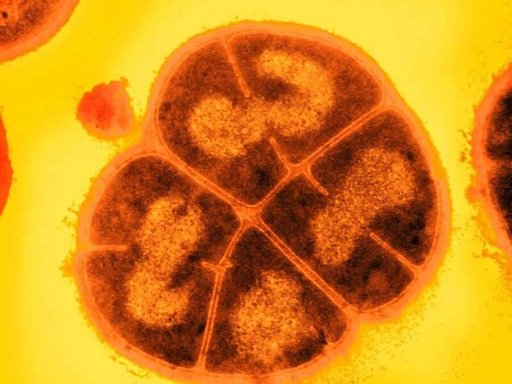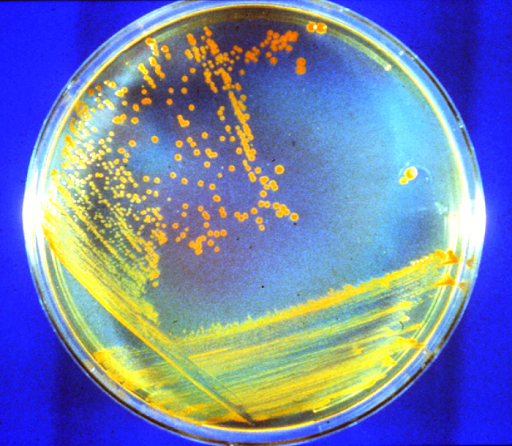By Raquel Santos

(Deinococcus radiodurans (Image by Michael J. Daly/USU) )
Knowing whether there is or ever was life on Mars is a question that we’ve always asked ourselves. There was never any solid indication that there was any form of life on our neighboring planet. Until now.
Researchers at Northwestern University conducted an experiment in which they simulated Mars’ radiation conditions to see how long dried, frozen bacteria and fungi could survive. They concluded that Deinococcus radiodurans, also known as ‘Conan the Bacterium’, could survive 280 million years if buried.
This means that there could be some form of life on Mars, just below the surface, and that the chances of uncovering it are higher than ever.
A Hard-Knock Life on Mars
It’s not complicated to explain why it would be pretty much impossible to find life on Mars. The Red Planet’s environment is unforgiving with icy temperatures, solar protons, and cosmic radiation constantly bombarding its surface.
While there’s evidence that the planet was once more hospitable, it now resembles a frozen desert.
“There is no flowing water or significant water in the Martian atmosphere, so cells and spores would dry out,” said study coauthor Brian Hoffman. “It also is known that the surface temperature on Mars is roughly similar to dry ice, so it is indeed deeply frozen.”
Previous research suggested that some bacteria would be able to survive for up to about a million years beneath the surface of Mars. Now, scientists have discovered that perhaps some life forms could withstand the planet’s harsh conditions for a lot longer.
Martian Simulations – A Proof of Life?
A research team from Northwestern University conducted an experiment in which they simulated the martian environment and radiation to see if any kind of bacteria or fungi could survive underneath the surface.
They exposed six types of organisms to a simulation of the Red Planet’s surface and then zapped them with large doses of gamma radiation and protons to mimic radiation in space. One robust microbe, in particular, the Deinococcus radiodurans, showed promise against the simulated martian conditions.

(Conan the Bacterium in a dish (Image by Michael J. Daly/USU))
Using a spectroscopy technique, the researchers measured the accumulation of manganese antioxidants in the microbes’ cells. The more manganese antioxidants are present in the cells, the more resistant a microorganism is to radiation and the better odds it has of survival.
The accumulation of the substance on Conan the Bacterium was such that it would be able to take 140,000 grays of radiation, a dose that’s 28,000 times greater than what would kill us, humans.
Ultraviolet light would kill this microorganism in a few hours if it were exposed to the surface. However, if it were buried just 10 centimeters beneath the surface, its lifespan would increase to 1.5 million years. Burying it 10 meters below showed that Deinococcus radiodurans could survive up to 280 million years.
Conan the Bacterium’s survival skills are due to its genetic code. This microorganism’s chromosomes and plasmids are perfectly aligned and linked together in a way that allows for careful repair after intense radiation exposure.
But what does this all mean exactly?
The Risk of Interplanetary Contamination
If any bacteria or fungi similar to Deinococcus radiodurans ever existed on Mars, particularly during a time when the water stopped flowing, its remains might still be dormant just under the surface.
“Although D. radiodurans buried in the Martian subsurface could not survive dormant for the estimated 2 to 2.5 billion years since flowing water disappeared on Mars, such Martian environments are regularly altered and melted by meteorite impacts,” Michael Daly said. “We suggest that periodic melting could allow intermittent repopulation and dispersal. Also, if Martian life ever existed, even if viable lifeforms are not now present on Mars, their macromolecules and viruses would survive much, much longer. That strengthens the probability that, if life ever evolved on Mars, this will be revealed in future missions.”
Future missions like ExoMars, the Mars Life Explorer, and the Mars Sample Return programs will extract and return materials from about two meters below Mars’ surface. The teams hope that these extractions can prove whether life ever existed on the Red Planet.
If there is in fact evidence that there are any dormant life forms on Mars, there might be risks of contamination. Future missions and astronauts might contaminate the planet with their microbes.
“Our model organisms serve as proxies for both forward contamination of Mars, as well as backward contamination of Earth, both of which should be avoided,” said Michael Daly. “Importantly, these findings have biodefense implications, too, because the threat of biological agents, such as Anthrax, remains a concern to military and homeland defense.”
The study, “Effects of desiccation and freezing on microbial ionizing radiation survivability: Considerations for Mars sample-return” was published in the journal Astrobiology and can be found, here.
Sources:
